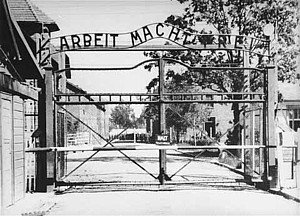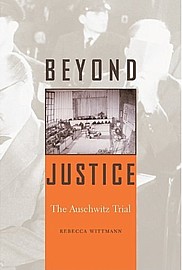Essay (back
to top)
Justice against Nazism
 With
the fall of the Nazi regime and the occupation of Germany by France, Britain,
the United States, and the Soviet Union, a new government had to be established.
One of the most difficult tasks for the occupying powers was to figure
out how to punish former Nazi party members who committed criminal acts
during the partyís time in power and by what means they should be tried
(international trial or locally held by German judges). With
the fall of the Nazi regime and the occupation of Germany by France, Britain,
the United States, and the Soviet Union, a new government had to be established.
One of the most difficult tasks for the occupying powers was to figure
out how to punish former Nazi party members who committed criminal acts
during the partyís time in power and by what means they should be tried
(international trial or locally held by German judges).
Prior to reading Rebecca Wittmanís book Beyond Justice, which
deals with the above mentioned issue, a few questions came to mind, many
of which Wittman thoroughly answered. Were former Nazis allowed to "disappear"
by either assimilating into German society, or did they go into exile
fearing legal ramifications for their actions? How were their crimes against
humanity handled during Germanyís time of occupation and after? How and
by what means were they able to orchestrate trying people who committed
crimes? How did they track down these criminals?
Public reaction to the trial is of great significance. Public reaction
contributes to the significance the Auschwitz trial has on German history.
Newspaper publications played a huge role in bringing the trial to the
public, but it can be argued that their skewed view, which primarily focused
on the atrocities of the Holocaust and not on the trial itself, contributed
to the German publicís collective guilt resting on the shoulders of the
defendants on trial. Essentially, the trial made Germans aware of the
broad scope of horrific atrocities which occurred during the Nazi reign,
but in effect, this awareness did not lead to the publicís acceptance
of responsibility for the Holocaust tragedies.
Beyond Justice: The Making of the Auschwitz Trial
The main focus of Beyond Justice is the timeline of the Auschwitz
trial. Wittman uses this trial as a basis to give the history of how the
German judiciary formed and how it differed from judicial decisions made
by occupying nations. The book is divided into six chapters, the first
starting with pretrial history and the last ending with the response to
the verdict. One of the earliest Nazi trials was the Nuremberg trial of
1945. The main goal of the occupying allies was to seek justice. The trial
was seen as a "victorís justice" in the sense that the victorious
Allies were the ones who conducted the trials, and thus came off as impartial
(22). Since they had the power to do what they wanted, people thought
the victors were biased. The International Military Tribunal (IMT) listed
three things as of utmost importance in the trial: crimes against peace,
war crimes, and crimes against humanity (20). The IMT stipulations just
mentioned were important inconsideration to the independently formed German
judicial system that took its time to form in 1945-1950.
Germany had to decide how it wanted to deal with its Nazi past. Should
former Nazis be allowed to assimilate into society or be held accountable
for their actions? Chancellor Adenauer wanted to "Integrate rather
than alienate ex-Nazis, because as many saw it, "one could have either
democracy or justice but in the early days, certainly not both" (26).
Opponents to Adenauerís idea of integration wanted to incorporate the
Nazi past into Germanyís democratic future. The West German judicial system
decided to try Nazi criminals under the German penal code (28). Up until
1955, court guidelines were being created, one in particular, the Transition
Agreement which stipulated that German courts could not investigate or
try anyone who had already been investigated by the occupying powers (28).
Under the West German judicial system, it had to be decided what constitutes
a punishable crime. It had to be determined if a Nazi committed the crime
of murder with the intention of killing or committed the crime due to
command, as an example states "a person is not guilty of murder because
he pulled the trigger and killed another person, but because he pulled
the trigger with the intention of killing the other person and succeeded
in doing so" (37). Titling crimes as manslaughter or murder was difficult
because determining the mental state of those on trial at the time the
crime was committed was questionable. Debates formed over the statutes
of limitations. Eventually it was ruled that 1925-1949 would not be included
in calculating the twenty year and thus Nazi murders could be tried until
1969.
Following the IMT Nuremberg trial, the German public had little interest
in the prosecution of former Nazis. Political focus had shifted to rebuilding
the nation and establishing a democratic government. It was thought that
actively pursuing former Nazis would work against the formation of a democracy.
The public didnít ardently oppose politiciansí ideas of allowing former
Nazis to assimilate into society.
Creating a body of law in which to conduct trials was only the first
step leading up to the Auschwitz trial. Next was the pretrial investigation.
It took years to shuffle through thousands of documents listing crimes
and witness testimonial accounts. Witnesses themselves had to be investigated
to determine the legitimacy of their accusations. Not all testimonies
were accepted; falsifications slowed down the pretrial investigations.
The trial was moved to Frankfurt where specific evidence was gathered
for the Auschwitz trial.
Many former Nazis blended back into German society. The pretrial investigation
period was not used for tracking down former Nazis. Rather survivors came
forward to authorities telling them that they had seen these former Nazis
around town. Letters were published in newspapers around the world asking
witnesses to come forward and provide testimony. Survivors in France,
Canada, Argentina, and other countries wrote in offering themselves as
witnesses (68). Concentration camp survivors came forth with details regarding
Nazi record keeping and falsifications within those records. The Nazi
regime was rigorous in record keeping and prisoner numbers. All prisoner
deaths had to be recorded. These Nazi records came back to haunt them
in trial.
The Trial
Following the pretrial investigation is the process of indictment. The
trial opened in Frankfurt on December 17, 1963. The indictment is a 700
page document containing two parts: "first, a historical overview
of the SS, the concentration camp system, and Auschwitz itself; the second,
the charges against the defendants" (96). Twenty-four defendants
were put on trial.
December 20, 1963 saw the start of the trial. The court was composed
of three judges and six jurors. The Holocaust as an event was not the
focus of the trial but rather the actions of individuals. Prosecuting
attorney Fritz Bauer tried to put the whole Auschwitz concentration camp
on trial, but was constrained by the statute of limitations. Witness testimony
was used to determine the truth of atrocities. The defendants on trial
tried to portray themselves as mere puppets following orders sent down
the Nazi hierarchy.
Press coverage of the trial spread all over the west. Coverage allowed
the public to know what the atmosphere was like inside the court. Most
of the coverage focused on the brutal and sadist actions described in
court (176). Newspapers stuck to that facet of the trial because graphic
headlines grabbed the attention of readers and sold more papers. The publicís
attention was taken away from the trial and engrossed with the sadistic
and horrendous aspects of the Holocaust. On several occasions, articles
about irrelevant testimony were published due to the sheer gore factor
it offered its readers.
The court reached its verdict on August 19-20, 1965. The judges estimated
the number of murders committed by each defendant (209). The judgment
in the files of the Auschwitz case "is more than nine hundred pages
long. It includes specific reasoning and evidence for the verdict issued
in the case of each defendant" (215). In figuring out the length
of each sentence of the defendants, the court had to examine each individual
case of aiding and abetting; "it then decided that none of the defendants
had acted in such a manner as would incur a punishment of more than fifteen
years" (223). The reasoning for this is that the defendants, prior
to the Nazi regime, lived their lives without being law breakers. After
the fall of the Nazi regime, they resumed this standard of citizenry.
How the public reacted to the verdict
Like previous post-World War II trials such as the Nuremberg
trials and Adolf Eichmannís trial in Jerusalem, the Auschwitz trial made
Germany face its Nazi past. Wittmann feels that the Auschwitz trial is
Germanyís first major attempt to confront the countryís past, but the
way the media portrayed the events of the trial to the public, separated
the public from their contribution to the Nazi past. Since they did not
participate in the sadistic acts like the defendants at the Auschwitz
trial, they were not responsible for the crimes. Many in Germany felt
as if they had been brainwashed, and were thus victims of the Nazi regime.
It is hard to truly gauge how the German public felt about the verdict
because there is no accurate survey that reflects public sentiment. Hannah
Arendt, a reporter from the Eichmann trials who documented his evil in
a book felt that the Auschwitz trial had no impact "on the climate
of public opinion" (247). Others felt that the men on trial were
scapegoats for the masterminds of the genocide who were now integrated
into society or dead. Some felt that the trial did what it was supposed
to do and brought the Nazi crimes to Germanyís attention. Bauer was unhappy
with the courtís decision to reduce many of the verdicts from murder to
aiding and abetting murder. Bauer and the rest of the prosecutors had
"three strikes against them: the law itself was much too restrictive,
legal theorists (and the federal court of appeals) had set standards that
favored mild sentences for most Nazi defendants, and the judge chose not
to challenge precedent" (273).
What do we get from the Trial? Wittmann feels that the trial is central
to German post-war reckoning with the past (273). It could be drawn from
the verdicts that only those who went above and beyond orders given from
the top of Nazi command were found guilty of murder. Wittmann concludes
by saying "Justice Ė equity, the quality of being morally just, rectitude,
the vindication of right through judgment in a court of law, and punishment
Ė is more a pursuit than a result in trials against Holocaust perpetrators"
(274).
|

 With
the fall of the Nazi regime and the occupation of Germany by France, Britain,
the United States, and the Soviet Union, a new government had to be established.
One of the most difficult tasks for the occupying powers was to figure
out how to punish former Nazi party members who committed criminal acts
during the partyís time in power and by what means they should be tried
(international trial or locally held by German judges).
With
the fall of the Nazi regime and the occupation of Germany by France, Britain,
the United States, and the Soviet Union, a new government had to be established.
One of the most difficult tasks for the occupying powers was to figure
out how to punish former Nazi party members who committed criminal acts
during the partyís time in power and by what means they should be tried
(international trial or locally held by German judges).